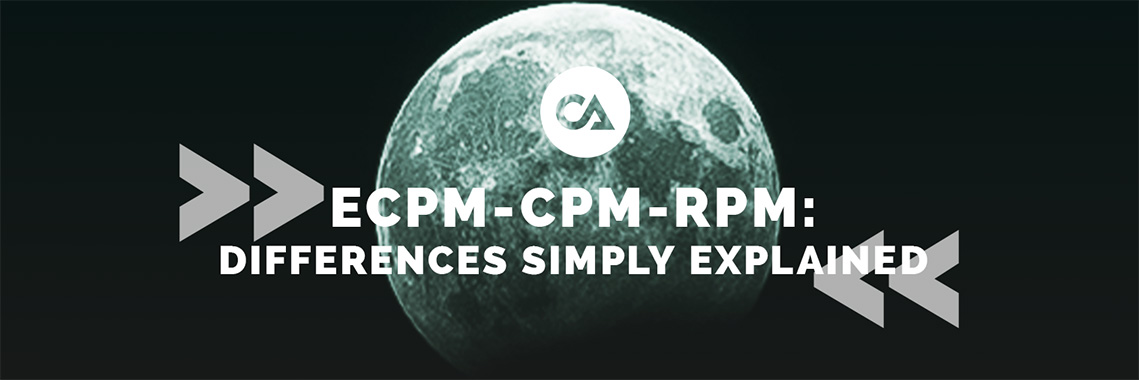If you’re like us in the world of programmatic advertising, you’re probably familiar with the feeling of swimming in an alphabet soup from time to time. Because let’s be honest: our industry is the world champion of abbreviations. We throw acronyms around like confetti at a party – and CPM, eCPM and RPM are no exception. But don’t worry! Because today we’re taking apart the supposed secret codes. We’ll show you what’s behind these mysterious shortcuts and why publishers should know their way around them.
CPM: Counting Pennies Meticulously or Climbing Piles of Moolah?
Joking aside, CPM stands for neither one thing nor the other. CPM stands for ‘Cost Per Mille’ or cost per 1000 impressions. It is an advertiser-centric metric meaning advertisers set their CPM as their desired price per 1000 ads served. They therefore use the CPM when they set up the budget for their ad campaigns. This makes the CPM a great metric used by advertisers to measure the cost of the campaign. It tells them how much the publisher pays for every 1000 impressions. This allows them to evaluate the effectiveness of the ad placement and also compare offers from different publishers.
CPM = (Total campaign budget / Total ad impressions)*1000
You might be thinking, all well and good that the CPM is so important for advertisers, but what do we publishers have to do with it? Well first of all, if you are directly working with advertisers, you need to know their metrics to close the deal. Second, CPM as a pricing model allows publishers to earn revenue based on ad impressions rather than ad performance. Publishers only need to generate traffic to earn money. It is a predictable revenue stream. Third, because CPMs vary by demand partner, geographic location, format, device and many other criteria, publishers can compare the performance of different ad units, formats and audiences and make data-driven decisions about which ads to prioritize. Through these same observations and resulting optimizations, publishers can ultimately increase their revenue.
eCPM: Elevating CPM to ‘Effective Cash Printing Machine’
eCPM, or “Elevating CPM to ‘Effective Cash Printing Machine'” (we wish we could make this wording official 😉 ), is nothing less than the superhero version of CPM. It stands for ‘Effective cost per mille’ and is a key metric for publishers to determine the revenue generated from every 1000 impressions of all the different campaigns running on the publishers inventory, including CPM, CPC (‘Cost per Click’) and CPL (‘Cost per Lead’) campaigns.
eCPM = (Total ad revenue / Total ad impressions)*1000
Why eCPM is so important for publishers is obvious: It tells you how much you can actually earn and helps to predict your future revenue in a standardized way, regardless of the channel, ad type or pricing model. By calculating the revenues generated per every thousand impressions publishers are able to compare a lot of things which helps to make data-driven decisions to optimize revenue. If you are a publisher operating various sites and apps, eCPM is also a great metric to compare the performances of all digital assets, because it tells you how much you make per thousand impressions for one site vs. another. Based on this information, you can make improvements to the other one. The eCPM is also a meaningful metric for comparing the performance of different ad platforms. Last but not least, monthly eCPM data helps to find out at what times (for example often around christmas time) advertisers increase their ad spending, which in turn can help to set prices more effectively.
RPM: Really Pumping Moolah or Rolling in Profits Mirthfully?
RPM, or “Really Pumping Moolah” (or perhaps “Rolling in Profits Mirthfully”?), goes beyond just ads. It’s the maestro of revenue, considering all the moolah-making moves you are making in your digital publishing space. RPM stands for ‘Revenue per Thousands’ and is used by the publisher to find out the revenue generated per thousand pageviews on their website. In general it is always higher than the CPM or eCPM, as it calculates the cost per 1000 pageviews and includes all ads on the page, whereas the CPM and eCPM calculates the costs per 1000 impressions of a single ad unit.
RPM = (Estimated earnings / No. of pageviews)*1000
RPM is important for publishers because it provides an even more detailed picture of the revenue generated from advertising by focusing only on the revenue generated and ignoring the cost of the ad. It helps them to identify high-performing ad placements such as their site’s most lucrative ad placements, adjust positions and prices and land better deals with advertisers. By using RPM publishers ensure that they make the most of their monetization efforts und that they maximize their revenue.
… and now let’s go and conquer the ad acronym abyss!
So, dear publishers, armed with the knowledge of CPM, eCPM, and RPM, you’re now equipped to navigate the ad acronym abyss like a true alphabet soup champ! And even more important: you now have some key metrics at hand that help you to understand the advertiser side of the business and to measure the cost of advertising (CPM), that help you to compare the performance of different ad units (eCPM) and that help you to understand your overall revenue generated per thousand pageviews (RPM).
Any questions? Don’t hesitate to reach out. We are glad to navigate even deeper into the jungle of abbreviations as it is our daily business 😉
